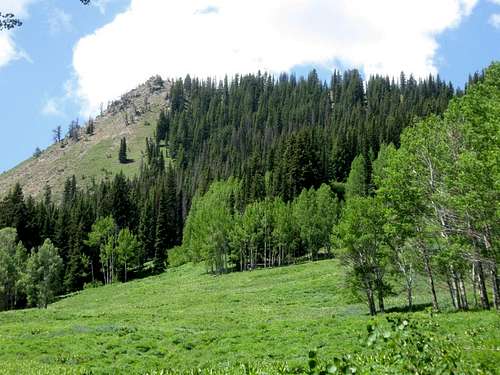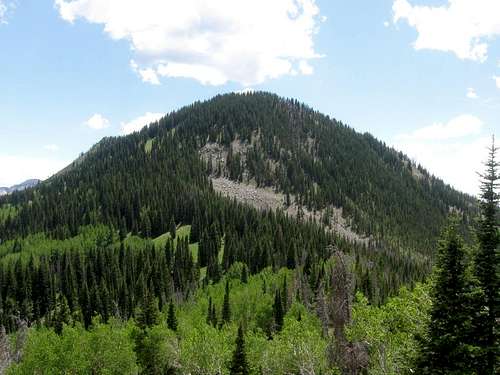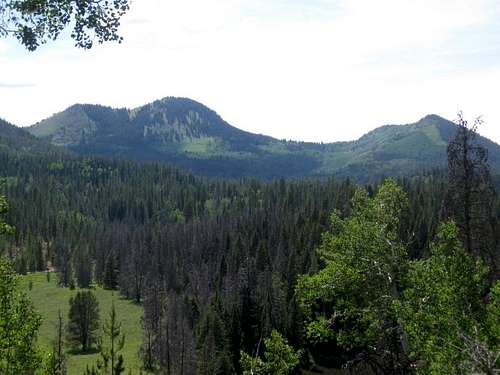|
|
Mountain/Rock |
|---|---|
|
|
40.83784°N / 107.05085°W |
|
|
Routt |
|
|
Hiking, Mountaineering, Scrambling, Skiing |
|
|
Summer, Fall |
|
|
10261 ft / 3128 m |
|
|
Overview
Slater Peak is the local name for Peak 10,261 (formerly peak 10,252) in the northeast section of the Elkhead Mountains. The mountain is steep, but mostly forested and not as conspicuous as some of its neighbors such as Nipple Peak, Sand Mountain and Hahns Peak. It lies about halfway between Diamond Peak on the south and Nipple Peak on the north. From any road, it is only highly visible from the immediate vicinity around Hahns Peak Lake.
When we climbed Slater Peak on June 16 2012, we found six signatures in the summit register in the last nine years (two in 2003, one in 2004, one in 2006, one in 2008, and one in 2009), making this an average peak in popularity for the 10,000+ foot peaks in the Elkhead Mountains.
Several aspects of the Elkhead Mountains make this a rather unique mountain range in Colorado. It is certainly possible that the Elkhead Mountains are the least known of the major mountain ranges in Colorado. This is partially because the range is a long way from any metropolitan area, and partially because the Elkhead Mountains are fairly low by Colorado standards, as there are no peaks reaching 11,000 feet. There are also few lakes, so the range isn’t visited by fishermen. Despite their low altitude, the Elkhead Mountains receive much snow, and snow lasts into July or later on the higher peaks. Most of the peaks in the Elkhead Mountains see very few ascents, but Hahns Peak, the eastern-most peak in the range is a popular climb for residents of Steamboat Springs. The Bears Ears see quite a few ascents by Elkhead standards, because of their prominent shape and visibility from the Yampa River Valley. Black Mountain is also climbed fairly often because it is the highest point in Moffat County, and the popularity is on the increase with more county highpointing interest. Sand Mountain must be a fairly popular (by Elkhead standards) climb as well, as there is a trail to the top, and as it is the first and only mountain in the range where I have ever met anyone. This was on Labor Day weekend, 2005, when we saw 3 other hikers. Most of the rest of the peaks see few ascents, and one ranger has told me some of the peaks only have a few names in the registers since 1980. So, there are few hikers around, but hunting is another story. The Elkhead Mountains are very popular for hunting in the fall and contain large populations of deer, elk, bear, etc.
One thing unique about the range is that hiker use is overall actually decreasing, rather than increasing as it is in most places in Colorado. The summit registers (which the Forest Service keeps record of) on most peaks indicate that they have had more ascents in the 1960’s and 1970’s than they do now. Even before that, there were many summit logs from the 1930’s and 1940’s from sheepherders.
The Elkhead Mountains are made of old volcanic rocks 17-25 million years old. One thing unusual is that the Elkhead Mountains run west to east as opposed to north and south as most of the ranges run in North America. It is impossible to describe the general forms of the peaks because they are all so different, but most of the peaks are isolated rises from a huge plateau which forms the bulk of the Elkhead Mountains.
Slater Peak is the 14th highest ranked peak in the Elkhead Mountains. Next to Columbus Mountain (the access of which is blocked by a strip of private land, Slater Peak was the last of the 10,000+ foot peaks in the Elkhead Mountains that I climbed.
Elkhead Mountains-10,000+ Foot Peaks with 300+ feet of Prominence
Navigational Warning
Warning:
The topo maps available don’t show the roads or trails around this mountain accurately. The closest one that bears resemblance to reality is the Forest Service Map-Routt National Forest, but it is of a small scale. The USGS maps don’t show many of the roads in the areas, but seem to show roads and trails that don’t exist; at least not any more.
Update:
The USGS has (finally) updated the 7.5 minute maps. They were scheduled to be produced for Colorado last year, but I’m not sure when they will hit all the stores. Right now you can get/see/print/buy the new 7.5 minute maps on My Topo.
The good news is that all the roads and trails are FINALLY accurate for the Elkhead Mountains (and undoubtedly other areas as well). After receiving the new maps, I am very pleased to see that the roads and trails are in the right places. I am also very pleased that the USGS has a new agreement with the US Forest Service and within the national forest service areas, the private land holdings are shaded (but only in USFS areas, land ownership is not shown outside FS lands) on the 7.5 minute scale maps.
Getting There
From Steamboat Springs, drive to the north end of town and to where County Road 129 leaves Highway 40. A sign marks "Clark" and "Hahns Peak". This is the same road heading to the airport. Drive north on CR 129 for approximately 30.8 miles.
Turn left (east) on FR 129 (gravel), marked for Hahns Peak Lake, to another junction after 2.1 miles. Turn right and follow the road for 2.3 miles, around a bend to the trail marked as “Prospector Trail”. A small parking area is just beyond the trail sign.
The road can be slightly rough near the end, but is usually good for all vehicles during the summer season.
Routes Overview
“Bumble Bee Ridge”
This is the north ridge of Slater Peak. We named it the Bumble Bee Ridge because on our trip there were more bumble bees than we had ever seen. Every flower had 2-3 bumble bees on it!
The route follows the Prospector Trail to the saddle between Slater Peak and North Slater Peak after which the steep north ridge of Slater Peak is followed to the summit. The round trip distance is only about 3.4 mile with 1500 feet elevation gain, but with a steep off trail scramble for the 2nd part of the route. See the route page for details.
Other Routes
Joseph Kramarsic mentions that the south ridge is a viable route as well. The east face of the mountain is very steep and probably not so pleasant.
Red Tape
There is no red tape here, so make sure to tread lightly.
Camping
There are many informal campsites along the road to the trailhead.
Hahns Peak Lake is a Forest Service Campground and is very close to the trailhead. Also in the same general area to the east are the campgrounds at Pearl Lake and Steamboat Lake State Park. These are crowded on summer weekends, and reservations are recommended. All the campgrounds are fee-use areas.
When to Climb
Late June or early July through early September could be considered the normal season to climb the mountain. The access roads do not open until late June or early July in most years. These roads could certainly be walked, snowshoed, or skied before then (though it would be a very long one day or easier two day trip).
A snowmobile would make this a one day climb in the winter. The Elkhead Mountains are a very popular hunting destination in late August, September and October (until snow closes the road), so use extreme caution at this time of year.
 South Ridge of Slater Peak in mid June. 2012 was an extremely warm and dry year. Usually the mountain would still be covered in snow in mid June.
South Ridge of Slater Peak in mid June. 2012 was an extremely warm and dry year. Usually the mountain would still be covered in snow in mid June.Mountain Conditions
CLICK HERE FOR THE SLATER PEAKS AREA WEATHER FORECAST
Below is the National Weather Service Climate Summary of Steamboat Springs. The data is from 1908-2005. This is the closest long term weather station, but be aware that higher elevations will be much wetter and colder. Steamboat Springs is at 6695 feet elevation, so expect the temperatures on Slater Peak to be 10-20 degrees colder than in Steamboat (except for cold winter nights).
| MONTH | AVE HIGH | AVE LOW | REC HIGH | REC LOW | AVE PREC (in) |
| JAN | 29 | 1 | 57 | -54 | 2.47 |
| FEB | 34 | 4 | 59 | -48 | 2.24 |
| MAR | 42 | 13 | 70 | -34 | 2.11 |
| APR | 54 | 24 | 79 | -15 | 2.28 |
| MAY | 65 | 31 | 88 | 8 | 2.08 |
| JUN | 75 | 36 | 96 | 19 | 1.49 |
| JUL | 82 | 41 | 97 | 25 | 1.54 |
| AUG | 80 | 40 | 98 | 20 | 1.60 |
| SEP | 72 | 33 | 93 | 6 | 1.81 |
| OCT | 60 | 24 | 89 | -16 | 1.89 |
| NOV | 43 | 14 | 72 | -28 | 1.97 |
| DEC | 31 | 3 | 64 | -44 | 2.38 |





